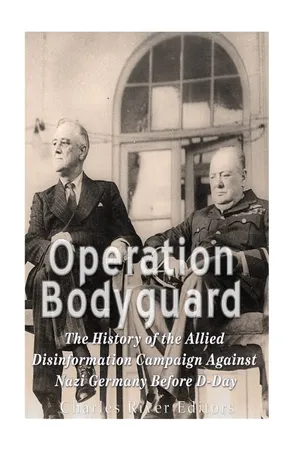In the summer of 1943, as Allied forces pushed through Sicily, an invisible war was being waged behind the scenes. This wasn’t a battle fought with tanks or aircraft but with typewriters, maps, and imagination. Operation Bodyguard was systematically dismantling German intelligence from within, creating phantom armies, nonexistent invasion plans, and illusory threats that would disperse Nazi forces across Europe at the most critical moment of World War II.
The Strategic Problem
By early 1943, the Allies faced a fundamental challenge: They needed to land in Europe to defeat Nazi Germany, but any direct assault against Hitler’s Atlantic Wall would result in catastrophic casualties. The disastrous raid on Dieppe in August 1942, where nearly 60% of the 6,000 troops who landed became casualties, had made this painfully clear.
The Allies couldn’t hope to achieve complete surprise, not with German radar installations scanning the skies and waters and intelligence networks watching for any hint of Allied intentions. But, what if they could persuade the Germans to position their forces in the wrong places?
This question gave birth to what Winston Churchill eloquently described during the Tehran Conference in late 1943: “In wartime, truth is so precious that she should always be attended by a bodyguard of lies.” The name stuck, and Operation Bodyguard was born.
The Architects of Deception
The London Controlling Section (LCS), established in 1942 under the direct authority of the War Cabinet, became the nerve center of Allied deception. At its head was Lieutenant Colonel John Bevan, a peacetime stockbroker with no previous intelligence experience but with a mind perfectly suited to strategic deception. Working alongside Bevan was a remarkable collection of individuals who in civilian life had been novelists, lawyers, journalists, stage magicians, and scientists.
Perhaps the most influential figure was Dr. Reginald Victor Jones, the head of scientific intelligence at MI6. Jones understood that modern warfare had become a battle of technologies and information, and he recognized that German intelligence gathering had patterns and vulnerabilities that could be exploited.
These deception planners operated on what today we might call “confirmation bias.” They understood that people tend to interpret new information in ways that confirm their existing beliefs. Hitler was convinced that the Allies would invade at the Pas-de-Calais, the narrowest point between England and France. Rather than try to change his mind, Bodyguard would reinforce this preconception, making it so unquestionable that even when confronted with the reality of the Normandy landings, he would still believe Calais was the main target.
The Machinery of Deception
Operation Bodyguard wasn’t a single deception but a symphony of coordinated operations, each playing off the others to create a comprehensive false narrative. At its core were several key objectives: convince Hitler that the Allies would invade later than planned, at different locations than intended, and with different forces than actually existed.
The deception created the illusion of threats across Europe—in Norway, the Balkans, the Mediterranean, and southern France—forcing Hitler to disperse his forces rather than concentrate them where the actual invasion would occur.
Physical Deception
Across southeastern England, opposite the Pas-de-Calais, an entire phantom army gradually took shape. From the air, German reconnaissance photographers captured images of tank formations, aircraft on runways, and massive supply dumps.
What German intelligence couldn’t know was that many of these tanks were inflatable rubber mockups that could be set up in hours. The aircraft were often plywood structures or canvas stretched over frames. The supply dumps were largely empty. Yet from high altitude, casting authentic shadows and showing signs of appropriate camouflage, they created a completely convincing picture.
Special units like the Royal Engineers’ “R Force” became experts in tactical deception, creating dummy equipment that from aerial reconnaissance was indistinguishable from the real thing. Even the sensory experience was designed to be convincing—smoke generators created the emissions patterns of field kitchens and vehicle parks, gravel was deliberately disturbed to show vehicle tracks, and workers regularly moved dummy equipment to simulate the activities of a real army preparing for combat.
Signals Deception
The airwaves hummed with radio traffic between nonexistent units. Teams of operators maintained the communication patterns that would be expected from a large military formation preparing for combat operations. Each fake unit had its own communication “fingerprint”—patterns that German signals intelligence had been trained to recognize.
The attention to detail was extraordinary. Operators would simulate the individual quirks of different radio operators, from typing speed to common mistakes. Some messages contained deliberate errors that would later be corrected, creating the natural pattern of human communication. The deception planners even factored in how message volume would increase as the invasion date approached.
Controlled Leaks
The planners of Bodyguard understood that information gained through apparently accidental means carries special credibility. They arranged for classified documents to be “carelessly” left where they might be photographed by enemy agents. Officers would have “indiscreet” conversations in locations known to be monitored by German intelligence.
In neutral countries like Portugal, Spain, and Sweden, British and American officers would sometimes get strategically “drunk” and reveal what appeared to be secret information—information carefully crafted by the deception planners to reinforce the false narrative.
The Double-Cross System
At the heart of Bodyguard was one of the war’s best-kept secrets: By 1943, British counterintelligence had captured or turned every single German agent operating in Britain. Given the choice between execution and working for the Allies, these agents became double agents, feeding carefully crafted misinformation back to their handlers in Germany.
This “Double-Cross System” created a closed loop of deception. German intelligence was receiving confirmation of the Bodyguard fiction from what they believed were their own trusted sources. The Germans were being systematically taught to lie to themselves.
The system worked because it occasionally permitted these agents to report genuine but non-critical information—enough truth to maintain credibility while the larger deception remained intact. The Double-Cross agents transmitted information through various means—radio messages, invisible ink letters, coded newspaper advertisements—creating a constant stream of intelligence that German analysts had to process.
The most valuable double agents had built reputations for reliability over years. Their German handlers trusted them implicitly. Some had even been decorated by Hitler himself for their supposed service to the Reich. This trust wasn’t just professional—it was personal. German intelligence officers’ careers and reputations hinged on the information these agents provided.
Operation Fortitude and the Phantom Army
Operation Fortitude was the largest component of Bodyguard, a massive deception split into two parts:
Fortitude North
Fortitude North suggested an impending invasion of Norway, playing on Hitler’s obsession with protecting the Nordic country, which he saw as critical for protecting Germany’s northern flank and securing vital Swedish iron ore.
The British created an entirely fictional army group—the British Fourth Army—supposedly assembling in Scotland. Daily situation reports detailed its growing strength. Training exercises focused conspicuously on mountain and cold-weather warfare. Even special equipment was ostentatiously tested where German intelligence might observe or hear about it.
Fortitude South
Fortitude South focused on convincing the Germans that the main Allied attack would come at the Pas-de-Calais. This deception centered around another phantom force—the First United States Army Group, or FUSAG.
The stroke of genius in Fortitude South was the appointment of General George S. Patton as FUSAG’s commander. The Germans respected Patton as one of the Allies’ most aggressive and effective generals and believed that any major offensive would surely be led by him. Patton was deliberately kept visible in England, reviewing troops and attending functions, all within the carefully orchestrated fiction.
The German Perspective
By early 1944, the German high command was drowning in information about Allied intentions—most of it deliberately false. Hitler’s military headquarters had become an echo chamber of confirming evidence. Intelligence reports, diplomatic cables, reconnaissance photos, agent reports—all pointed to threats that aligned with Hitler’s preconceptions.
German intelligence officers found themselves in an impossible position. Those who questioned the emerging consensus were quickly sidelined. Admiral Wilhelm Canaris, head of the Abwehr (German military intelligence), had grown increasingly skeptical of the information his service was receiving, but his warnings went unheeded. The system rewarded those who confirmed Hitler’s views and punished dissenters.
For field commanders like Field Marshal Erwin Rommel, the uncertainty created by Bodyguard was maddening. Tasked with defending thousands of miles of coastline with limited resources, they had to make impossible choices about where to concentrate their forces. The constant stream of conflicting intelligence reports created a decision paralysis that favored the status quo—keeping forces dispersed rather than concentrated.
By spring 1944, German intelligence had identified at least five potential invasion areas: Norway, Denmark, the Pas-de-Calais, Normandy, and the Mediterranean. Each came with compelling evidence. Each required defensive preparations. Hitler, rather than choosing where to concentrate his forces, tried to defend everywhere—exactly as the Bodyguard planners had intended.
D-Day and Beyond
In the pre-dawn hours of June 6, 1944, as the actual Allied invasion force approached the Normandy coast, Operation Bodyguard faced its ultimate test. Would the Germans recognize the deception as the real invasion unfolded?
What happened next demonstrates the true brilliance of Bodyguard. Instead of ending with the Normandy landings, the deception continued. Double agents sent urgent messages to their German handlers confirming that Normandy was merely a diversion and that the main attack at Calais was still coming.
Even as Allied troops fought to establish their beachhead in Normandy, Hitler remained convinced that the real invasion was yet to come. He refused to release strategic reserves, particularly the powerful Fifteenth Army positioned opposite the Pas-de-Calais. For critical days and then weeks, these forces stood idle, awaiting an attack that existed only in the elaborate fiction created by Operation Bodyguard.
The numbers tell the story: On D-Day itself, the Germans had just 12,000 combat troops in the immediate Normandy invasion area, while nearly 150,000 German soldiers remained around Calais, defending against a phantom army. Throughout June and into July, Hitler continued to expect a second, larger landing.
Bodyguard’s effectiveness extended far beyond D-Day. For critical weeks afterward, German forces remained dispersed across Europe, in Norway, the Balkans, southern France, and the Pas-de-Calais, responding to threats that existed only in the minds of German leadership.
The deception only began to unravel in late July, when the Allied breakout from Normandy made the reality undeniable. By then, it was too late. The Allied foothold in Europe was secure, and the liberation of Western Europe had begun.
The Human Element
Behind the strategic maps and deception plans were human beings—individuals whose courage, creativity, and dedication made Bodyguard possible.
For the planners in London, the weight of responsibility was enormous. Lieutenant Colonel John Bevan later confessed to colleagues that he often couldn’t sleep at night, haunted by the knowledge that a single mistake in their deception could cost thousands of Allied lives.
For the double agents, the stress was even more acute. Living double lives, constantly at risk of exposure, they carried the burden of maintaining their deceptive personas without faltering. Some developed ulcers, others suffered nervous breakdowns. The psychological toll of sustained deception—of living a lie day after day—was immense.
The field operatives who implemented physical deceptions faced different challenges. Working around the clock to maintain the illusion of phantom armies, they operated in a strange world where appearance was everything and reality irrelevant. These men and women—many of them artists, set designers, and engineers in civilian life—brought a creative ingenuity to warfare that had never been seen before.
And what of the German intelligence officers who were the targets of this deception? Many were competent professionals, doing their best to serve their country in difficult circumstances. After the war, some admitted feelings of humiliation upon learning how thoroughly they had been deceived. Others expressed reluctant admiration for the complexity and effectiveness of Bodyguard.
The true success of Bodyguard is measured in the names not carved on gravestones, the telegrams not sent to anxious families, the lives not cut short on blood-soaked beaches.

